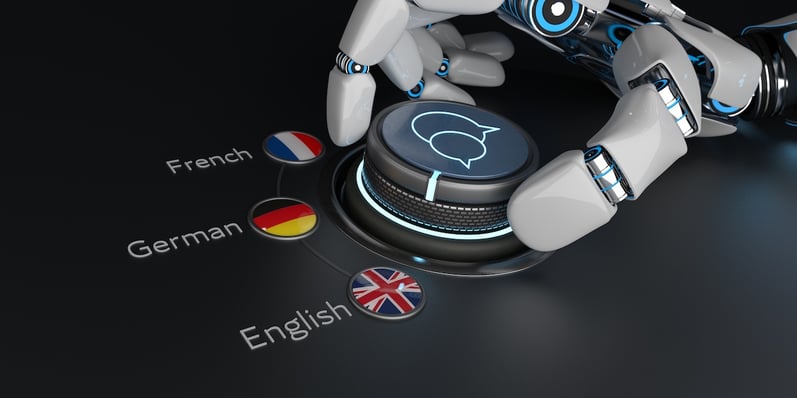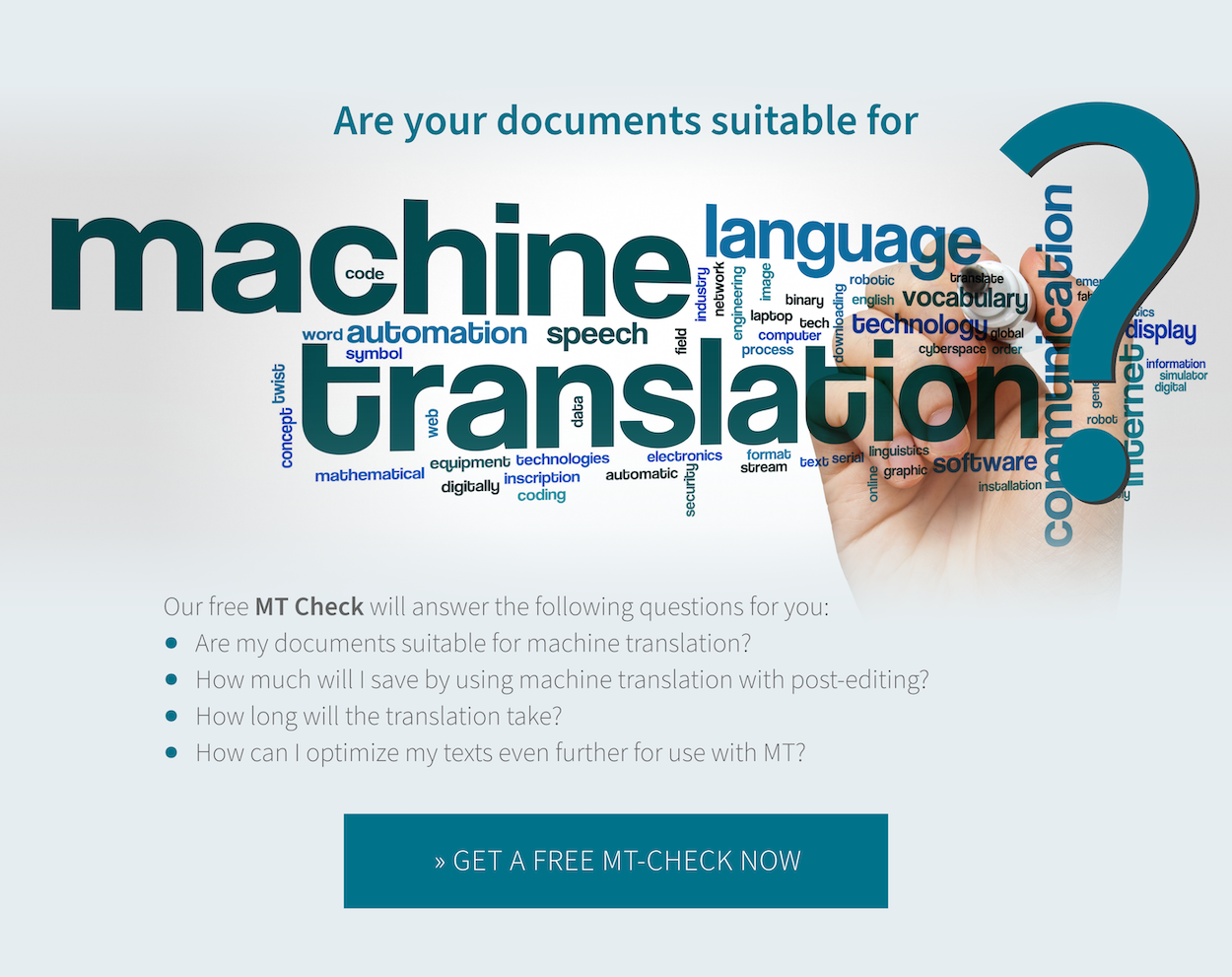
As artificial intelligence makes more and more of an impact in the translation industry, machine translation is becoming increasingly important. But even though many translations are now produced using this workflow, people still have lots of questions about it. MEINRAD answers 20 of the most frequently asked questions about machine translation and post-editing.
What are the benefits of machine translation?
What are the drawbacks of machine translation?
Does a human being need to be involved when using machine translation?
Is post-editing really necessary?
Are all texts suitable for machine translation?
Which texts are suitable for machine translation?
Which texts are less suitable for machine translation?
Which factors influence the quality of the machine translation output?
Can I do anything to influence whether my texts are suitable for machine translation?
Are all languages suitable for machine translation?
Which languages are suitable for machine translation?
Are my data secure when using machine translation?
How much time can I save using machine translation?
How much money can I save using machine translation?
Despite these savings, do I still get high-quality translations?
If I switch to machine translation, do I have to stick with it?
Do I need to make an initial investment?
What does the initial investment depend on?
What is machine translation?
Machine translation (MT for short) is the automatic (pre-)translation of texts using suitable MT software. That means texts are translated using artificial intelligence.
What are the benefits of machine translation?
Depending on the suitability of the source text, machine translation can save you time compared to human translation. In turn, that means you pay less for translations.
If you only use machine translation without subsequent post-editing, your translation costs will be basically zero as you’ll only have to pay for use of the machine translation engine. But we don’t recommend working without post-editing in many cases – internal company communication would be one example.
What are the drawbacks of machine translation?
Computers only “think” from sentence to sentence, so each segment is translated completely independently of the others. That means key terms are often translated differently at different points in the text, and the translation usually doesn’t “flow” very well or have the same style as it would if a native-speaker translator had produced it. And of course there’s a risk of mistakes in machine translation, which can bring safety risks with it.
Does a human being need to be involved when using machine translation?
Although MT tools have got better and better in recent years, machine translation can’t replace human beings. The machine translation output must be professionally post-edited. So all reputable translation agencies will only use MT in combination with full post-editing.
What is post-editing?
Post-editing is the process of editing a text which has been machine translated, and is carried out by a post-editor (a professional translator experienced in post-editing MT texts). They bring the machine translation output up to scratch by going through the translations produced by the MT engine and, where necessary, correcting the grammar, spelling and contents. Post-editors also ensure that the specific terminology required by the client has been used.
Is post-editing really necessary?
Yes, if you expect results comparable with human translation and want to minimize risks and comply with standards.
Are all texts suitable for machine translation?
No, not all texts are suitable for machine translation.
Which texts are suitable for machine translation?
The fewer cultural references and ambiguities contained in a text, the more suitable it will be for machine translation. If the text uses common vocabulary, short, clear and simple sentences, straightforward lists of terms and minimal or no specialist terminology, the MT engine will usually produce fluent results you can use.
Which texts are less suitable for machine translation?
All texts which contain ambiguities, which use wordplay and metaphors, or which have little context, are less suitable for machine translation. And you also shouldn’t expect good results from texts which use lots of uncommon abbreviations, proper names and product designations. Advertising texts of any kind and software texts with minimal context (GUI texts) are good examples.
Which factors influence the quality of the machine translation output?
Various factors influence how usable the machine translation output is:- MT software used → Can it be trained? Quality and amount of training data
- Quality and type of source text
- Language pair
Can I do anything to influence whether my texts are suitable for machine translation?
Yes, absolutely. The quality of the machine translation output depends in part on the quality of the source text, and there are formal criteria it’s a good idea to stick to when producing the text. These include using short, simple sentences and avoiding pronouns (“the device” rather than “it”), ambiguities and inconsistencies.Are all languages suitable for machine translation?
Although various MT tools offer a wide range of language pairs, for professional use at a translation agency you can’t rely on high-quality output for every language.
Which languages are suitable for machine translation?
MEINRAD has had good experiences with the Romance and Germanic languages, plus some Eastern European languages (e.g. German, English, French, Italian, Portuguese, Spanish, Dutch, Russian, Polish, Romanian, Slovak, Czech, Hungarian and Slovenian). But Asian languages such as Japanese and Chinese also produce usable results. And the technology isn’t standing still: the tools are constantly improving, meaning that more and more language pairs are becoming suitable for professional machine translation.
Are my data secure when using machine translation?
Yes, provided that you or the translation agency use fee-based Pro versions of MT software. It’s a good idea to look at the terms of service before using machine translation. Check out our E-book for more about machine translation and data security:
How much time can I save using machine translation?
Depending on the circumstances (quality of source text, terminology and term base, MT tool used), machine translation can reduce the time taken to deliver projects by around 30 to 50% compared to human translation.
How much money can I save using machine translation?
Machine translation can save you an average of 30% on your translation projects in absolute terms.
Despite these savings, do I still get high-quality translations?
Yes. Machine translation and post-editing produces results comparable with a human translation. And you can be even more confident of high-quality results if your translation agency is certified to ISO 17100 and ISO 18587 (post-editing of machine translation output).
If I switch to machine translation, do I have to stick with it?
No. Each time you order a translation, you can decide which workflow you’d like. If a particular text is unsuitable for MT, the translation agency will tell you and recommend a human translation. To ensure both sides know what’s going on, it’s a good idea to talk to your agency about classifying the types of text you have, so that you can decide which of your texts should be translated using machine translation. For example, all technical documentation should (if possible) be translated using machine translation and post-editing, while all marketing texts should be translated by humans.
Do I need to make an initial investment?
Whether you need to make an initial investment depends on the circumstances – sometimes you will, sometimes you won’t.
What does the initial investment depend on?
The initial investment involved in using machine translation depends on various factors: how suitable your source documents are, which and how many MT tools are being used, and how you wish to use them. Your translation agency can advise you.
Main image: © Adobe Stock



